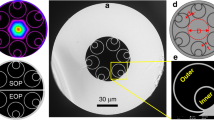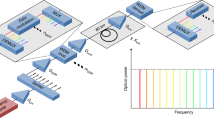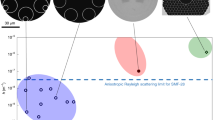Abstract
Wide-bandwidth signal transmission with low latency is emerging as a key requirement in a number of applications, including the development of future exaflop-scale supercomputers, financial algorithmic trading and cloud computing1,2,3. Optical fibres provide unsurpassed transmission bandwidth, but light propagates 31% slower in a silica glass fibre than in vacuum, thus compromising latency. Air guidance in hollow-core fibres can reduce fibre latency very significantly. However, state-of-the-art technology cannot achieve the combined values of loss, bandwidth and mode-coupling characteristics required for high-capacity data transmission. Here, we report a fundamentally improved hollow-core photonic-bandgap fibre that provides a record combination of low loss (3.5 dB km−1) and wide bandwidth (160 nm), and use it to transmit 37 × 40 Gbit s−1 channels at a 1.54 µs km−1 faster speed than in a conventional fibre. This represents the first experimental demonstration of fibre-based wavelength division multiplexed data transmission at close to (99.7%) the speed of light in vacuum.
This is a preview of subscription content, access via your institution
Access options
Subscribe to this journal
Receive 12 print issues and online access
$209.00 per year
only $17.42 per issue
Buy this article
- Purchase on Springer Link
- Instant access to full article PDF
Prices may be subject to local taxes which are calculated during checkout




Similar content being viewed by others
References
Papadopoulos, G. How to design and build your very own exascale computer. Proceedings of the Optical Fiber Communication Conference (OFC), Plenary Talk (Optical Society of America, 2012).
Freiberger, M., Templeton, D. & Mercado, E. in Proceedings of the National Fiber Optic Engineers Conference (NFOEC), paper NTu2E.1 (Optical Society of America, 2012).
Lam, C. et al. Fiber optic communication technologies: what's needed for datacenter network operations. IEEE Commun. Mag. 48, 32–39 (2010).
Amdahl, G. M. in Proceedings of the 1967 Spring Joint Computer Conference 483–485 (ACM, 1967).
Arvind, A. & Iannucci, R. in Parallel Computing in Science and Engineering Vol. 295 Lecture Notes in Computer Science (eds Dierstein, R., Müller-Wichards, D. & Wacker, H.-M.) 61–88 (Springer, 1988).
Allongue, B. et al. The electronics system of the ALFA forward detector for luminosity measurements in ATLAS. J. Instrum. 7, C02034 (2012).
Stenner, M. D., Gauthier, D. J. & Neifeld, M. A. The speed of information in a ‘fast-light’ optical medium. Nature 425, 695–698 (2003).
Birks, T. A., Roberts, P. J., Russel, P. S. J., Atkin, D. M. & Shepherd, T. J. Full 2-D photonic bandgaps in silica/air structures. Electron. Lett. 31, 1941–1943 (1995).
Cregan, R. F. et al. Single-mode photonic band gap guidance of light in air. Science 285, 1537–1539 (1999).
Ouzounov, D. G. et al. Generation of megawatt optical solitons in hollow-core photonic band-gap fibers. Science 301, 1702–1704 (2003).
Shannon, C. E. A mathematical theory of communication. Bell Syst. Tech. J. 27, 379–423 (1948).
Essiambre, R. J. & Tkach, R. W. Capacity trends and limits of optical communication networks. Proc. IEEE 100, 1035–1055 (2012).
Ellis, A. D., Jian, Z. & Cotter, D. Approaching the non-linear shannon limit. J. Lightwave Technol. 28, 423–433 (2010).
Roberts, P. J. et al. Ultimate low loss of hollow-core photonic crystal fibres. Opt. Express 13, 236–244 (2005).
Mangan, B. J. et al. in Proceedings of the Optical Fiber Communication Conference (OFC) paper PD24 (Optical Society of America, 2004).
West, J. A., Smith, C. M., Borrelli, N. F., Allan, D. C. & Koch, K. W. Surface modes in air-core photonic band-gap fibers. Opt. Express 12, 1485–1496 (2004).
Saitoh, K., Mortensen, N. A. & Koshiba, M. Air-core photonic band-gap fibers: the impact of surface modes. Opt. Express 12, 394–400 (2004).
Poletti, F., Broderick, N. G. R., Richardson, D. J. & Monro, T. M. The effect of core asymmetries on the polarization properties of hollow core photonic band gap fibers. Opt. Express 13, 9115–9124 (2005).
Amezcua-Correa, R., Broderick, N. G. R., Petrovich, M. N., Poletti, F. & Richardson, D. J. Design of 7 and 19 cells core air-guiding photonic crystal fibers for low-loss, wide bandwidth and dispersion controlled operation. Opt. Express 15, 17577–17586 (2007).
Amezcua-Correa, R. et al. Control of surface modes in low loss hollow-core photonic bandgap fibers. Opt. Express 16, 1142–1149 (2008).
Hansen, T. P. et al. Air-guiding photonic bandgap fibers: spectral properties, macrobending loss, and practical handling. J. Lightwave Technol. 22, 11–15 (2004).
Nicholson, J. W. et al. Measuring higher-order modes in a low-loss, hollow-core, photonic-bandgap fiber. Opt. Express 20, 20494–20505 (2012).
Wheeler, N. V. et al. in Proceedings of the Optical Fiber Communications Conference (OFC) paper PDP5A.2 (Optical Society of America, 2012).
Fokoua, E. N., Poletti, F. & Richardson, D. J. Analysis of light scattering from surface roughness in hollow-core photonic bandgap fibers. Opt. Express 20, 20980–20991 (2012).
Lyngso, J. K., Mangan, B. J., Jakobsen, C. & Roberts, P. J. 7-cell core hollow-core photonic crystal fibers with low loss in the spectral region around 2 µm. Opt. Express 17, 23468–23473 (2009).
Petrovich, M. N., Poletti, F., Van Brakel, A. & Richardson, D. J. Robustly single mode hollow core photonic bandgap fiber. Opt. Express 16, 4337–4346 (2008).
Euser, T. G. et al. Dynamic control of higher-order modes in hollow-core photonic crystal fibers. Opt. Express 16, 17972–17981 (2008).
Nicholson, J. W., Yablon, A. D., Fini, J. M. & Mermelstein, M. D. Measuring the modal content of large-mode-area fibers. IEEE J. Sel. Top. Quantum Electron. 15, 61–70 (2009).
Peucheret, C., Zsigri, B., Hansen, T. P. & Jeppesen, P. 10 Gbit/s transmission over air-guiding photonic bandgap fibre at 1550 nm. Electron. Lett. 41, 27–29 (2005).
Petrovich, M. N. et al. in Proceedings of the European Conference and Exhibition on Optical Communication paper Th.3.A.5 (Optical Society of America, 2012).
Acknowledgements
This work was supported by the EU 7th Framework Programme (grant agreement 228033; MODE-GAP) and by the UK EPSRC (grants EP/I01196X/1 (Hyperhighway) and EP/H02607X/1). F.P. and R.S. acknowledge support from a Royal Society University Research Fellowship and an EU FP7 Marie-Curie Fellowship (255368, TOP CLASS), respectively. Z.L. acknowledges support from the China Scholarship Council.
Author information
Authors and Affiliations
Contributions
F.P. and E.N.F. designed the fibre and modelled its loss contributions. N.V.W., M.N.P., N.B. and J.R.H. fabricated and characterized the fibre. R.S. conducted the ToF and data transmission experiments. D.R.G., Z.L. and F.P. conducted the S2 modal characterization. F.P., M.N.P. and D.J.R. contributed to the genesis of the idea and provided overall technical leadership across all aspects of the research. F.P., R.S. and D.J.R. wrote the manuscript.
Corresponding author
Ethics declarations
Competing interests
The authors declare no competing financial interests.
Rights and permissions
About this article
Cite this article
Poletti, F., Wheeler, N., Petrovich, M. et al. Towards high-capacity fibre-optic communications at the speed of light in vacuum. Nature Photon 7, 279–284 (2013). https://doi.org/10.1038/nphoton.2013.45
Received:
Accepted:
Published:
Issue Date:
DOI: https://doi.org/10.1038/nphoton.2013.45
This article is cited by
-
BioAIEgens derived from rosin: how does molecular motion affect their photophysical processes in solid state?
Nature Communications (2021)
-
Exceptional polarization purity in antiresonant hollow-core optical fibres
Nature Photonics (2020)
-
Perfect secrecy cryptography via mixing of chaotic waves in irreversible time-varying silicon chips
Nature Communications (2019)
-
Integrated Optical Modulator Based on Transition between Photonic Bands
Scientific Reports (2018)
-
Hollow-core conjoined-tube negative-curvature fibre with ultralow loss
Nature Communications (2018)



